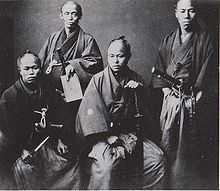Bombardment of Kagoshima
| Bombardment of Kagoshima (薩英戦争) | |||||||
|---|---|---|---|---|---|---|---|
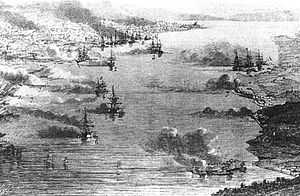 Bird's-eye view of the bombardment of Kagoshima by the Royal Navy, August 15, 1863. Le Monde Illustré. | |||||||
| |||||||
| Belligerents | |||||||
|
|
| ||||||
| Commanders and leaders | |||||||
|
|
| ||||||
| Strength | |||||||
| 7 steam warships |
3 steam ships 80 cannons | ||||||
| Casualties and losses | |||||||
|
3 warships damaged 11 killed, 52 wounded |
3 steamships damaged 5 killed | ||||||
| ||||||
The Bombardment of Kagoshima, also known as the Anglo-Satsuma War (薩英戦争 Satsu-Ei Sensō), took place on 15–17 August 1863 during the Late Tokugawa shogunate. The Royal Navy was fired on from coastal batteries near the town of Kagoshima and in retaliation bombarded the town. The British were trying to exact a payment from the daimyo of Satsuma following the Namamugi Incident of 1862, in which British nationals were attacked (one killed, two wounded) by Satsuma samurai for not showing the proper respect for a daimyo's regent (Shimazu Hisamitsu).
Background
Following the Namamugi Incident on September 14, 1862, Lieutenant-Colonel Neale, the British Chargé d'Affaires, demanded from the bakufu an apology and a huge indemnity for the Namamugi outrage of £100,000 ($440,000 in Mexican silver dollars), representing roughly 1/3 of the total revenues of the Bakufu for one year.[5] Neale kept threatening a naval bombardment of Edo if the payment was not made.[6] Britain also demanded of the Satsuma domain the arrest and trial of the perpetrators of the outrage, and £25,000 compensation for the surviving victims and the relatives of Charles Lennox Richardson.
The Bakufu (Japanese central government), led by Ogasawara Nagamichi in the absence of the Shogun who was in Kyoto,[7] eager to avoid trouble with European powers, negotiated with France and Great Britain on July 2, 1863, on board the French warship Sémiramis, apologized and paid the indemnity to the British authorities. Participating in the settlement were the main French and British political and navy representatives of the time: Duchesne de Bellecourt the French Minister in Japan, Lieutenant-Colonel Neale the Chargé d'affaires of Great Britain, Admiral Jaurès and Admiral Kuper.[8]
Satsuma Province however refused to apologize, to pay the compensation of £25,000 demanded by the British, or to convict and execute the two Japanese samurai responsible for the murder, arguing that disrespect to the Daimyō was normally sanctioned by the immediate death of those showing disrespect. Legally, their claim was invalid, as foreigners in Japan benefited from extraterritoriality due to Japan's reluctant acceptance of what the Japanese called the Unequal treaties with Europe. Japanese customary law did not apply to foreigners. However, politically, Satsuma felt it could not be seen as submitting to European demands in the very anti-foreign context at that time in Japan.
Great Britain, however, wished to make a point against anti-foreign outrages in Japan. Other anti-foreign troubles were occurring throughout the country at the same time, reinforced by Emperor Kōmei's 1863 "Order to expel barbarians". The European powers chose to react militarily to such exactions: the straits of Shimonoseki had already seen attacks on American, Dutch and French ships passing through, each of which had brought retaliation from those countries, with the U.S. frigate USS Wyoming under Captain McDougal, the Dutch warship Medusa under Captain François de Casembroot, and the two French warships Tancrède and the Dupleix under Captain Benjamin Jaurès attacking the mainland. Eventually, on 14 August 1863, a multinational fleet under Admiral Kuper and the Royal Navy commenced the Bombardment of Shimonoseki to prevent further attacks on western shipping there. They succeeded.
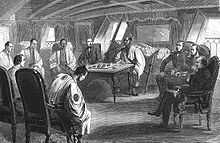
Protestations of the Bakufu
Following protracted and fruitless negotiations with Satsuma that had taken over a year, the British Chargé d'affaires eventually had had enough. Under British Government instructions, he required the Royal Naval Commander-in-Chief of the Far East and China Station to coerce Satsuma into complying with the British Government's demands. Informed of the plans, the Bakufu asked for a delay in its implementation:
"On receipt of your despatch of the 3rd of August, we fully understood that you intend to go within three days to the territory of the Prince of Satsuma with the men-of-war now lying in the Bay of Yokohama, to demand satisfaction for the murder of a British merchant on the Tokaido last year. But owing to the present unsettled state of affairs in our empire, which you witness and hear of, we are in great trouble, and intend to carry out several plans. Supposing, now, something untoward were to happen, then all the trouble both you and we have taken would have been in vain and fruitless; therefore we request that the said departure may be delayed for the present".—Edo, 4th of August, signed by four Minister of Foreign Affairs of the Shogunate.[9]
On the 5th, a Vice-Minister from Edo visited Colonel Neale, but far from further opposing the expedition actually transmitted that the Shogunate intended to send one of its steamers with the squadron. The steamer in question however did not join the expedition.[10]
Departure
The British squadron left Yokohama on August 6. It was composed of the flagship HMS Euryalus (with Colonel Neale onboard),[10] HMS Pearl, HMS Perseus, HMS Argus, HMS Coquette, HMS Racehorse and the gunboat HMS Havock. They sailed for Kagoshima and anchored in the deep waters of Kinko Bay on August 11, 1863. Satsuma envoys came aboard Euryalus and letters were exchanged, with the British commander pressing for a resolution satisfactory to his demands within 24 hours. The Satsuma clan prevaricated, refusing to comply for various reasons.
Combat
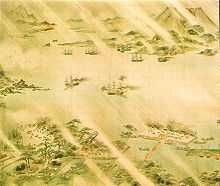
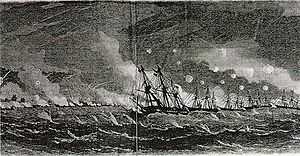
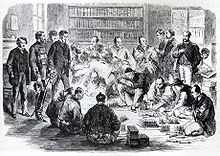
The deadline expired, and diplomacy gave way to coercion. Deciding to put pressure on Satsuma, the Royal Navy commander seized three foreign-built steam merchant ships (Sir George Grey, Contest, England, with an aggregate value of about $300,000/₤200,000 sterling or GB£128,000,000 in 2011 pounds)[11] belonging to Satsuma which were at anchor in Kagoshima harbour, to use them as a bargaining tool. Picking their moment, just as a typhoon started, the Satsuma forces on shore vented their anger by firing their round shot cannons at the British ships. Surprised by the hostility, the British fleet responded by first pillaging and then setting on fire the three captured steamships (to the chagrin of the British sailors, who were thereby deprived of prize money). Then, after nearly two hours getting ready (they had not expected or intended to get into any exchange of fire with Satsuma), a line of battle was formed, which sailed along the coast of Kagoshima and fired cannon shells and round shot. One of the British warships, the gunboat Havoc, set five Ryukyuan trading junks on fire.

The naval bombardment claimed five lives among the people of Satsuma (the city had been evacuated in anticipation of the conflict), and 13 lives among the British (including Captain Josling of the British flagship Euryalus, and his second-in-command Commander Wilmot, both decapitated by the same cannonball). Material losses were considerable, with around 500 wood-and-paper houses burnt in Kagoshima (about 5% of Kagoshima's urban area), and the three Satsuma steamships and five junks destroyed. The encounter was face-saving for Satsuma, and was even claimed as a victory by the Japanese side, considering the relative number of casualties. The British ships did not land troops or seize cannons (which would have signalled the absolute defeat of Satsuma), Kuper having decided that enough was enough.[12]
Final negotiations and convergence
Satsuma however later negotiated and paid ₤25,000 (which they borrowed from the bakufu and never repaid, due to the fall of the bakufu in 1869 and its replacement by the Meiji administration). They never produced or identified Richardson's killers, but despite this, the reparation received was enough to obtain an agreement by Britain to supply steam warships to Satsuma.
The conflict actually became the starting point of a close relationship between Satsuma and Britain, which became major allies in the ensuing Boshin War. From the start, the Satsuma Province had generally been in favour of the opening and modernization of Japan. Although the Namamugi Incident was unfortunate, it was not characteristic of Satsuma's policy, and was rather abusively branded as an example of anti-foreign sonnō jōi sentiment, as a justification to a strong European show of force.
An interesting historical footnote to this incident was that a young Heihachiro Togo was manning one of the cannons used to defend the port, and is reported to have attributed his future career as head and 'father' of the Imperial Japanese Navy to this moment.
See also
- Anglo-Japanese relations
- Bombardment of Shimonoseki
- Ishibashi Park
- Satsuma clan
- Satsuma Domain
Notes
- ↑ The Progress of the Japanese War. October 4, 1863 New York Times.
- ↑ https://books.google.fr/books?id=yYCT3qi8HNwC&pg=PA29&dq=anglo+satsuma+war+victory&hl=fr&sa=X&ei=PZ81VZvPLoWdsgHoroGgDA&ved=0CCAQ6AEwAA#v=onepage&q=anglo%20satsuma%20war%20victory&f=false
- ↑ https://books.google.fr/books?id=iNb0f3ab0HYC&pg=PA20&dq=anglo+satsuma+war+victory&hl=fr&sa=X&ei=PZ81VZvPLoWdsgHoroGgDA&ved=0CCgQ6AEwAQ#v=onepage&q=anglo%20satsuma%20war%20victory&f=false
- ↑ https://books.google.fr/books?id=RHXG0JV9zEkC&pg=PA168&dq=anglo+satsuma+war+victory&hl=fr&sa=X&ei=PZ81VZvPLoWdsgHoroGgDA&ved=0CEAQ6AEwBA#v=onepage&q=anglo%20satsuma%20war%20victory&f=false
- ↑ Totman, p.68-69
- ↑ Totman, p.71
- ↑ Totman, p.72
- ↑ 8.0 8.1 Polak 2002, p.92
- ↑ Quoted in Rennie, p.381
- ↑ 10.0 10.1 Rennie, p.382
- ↑ Measuring Worth, Relative Value of a UK Pound Amount - average earnings, retrieved: 7 May 2011
- ↑ Denney, p.191
Bibliography
- Denney, John. Respect and Consideration: Britain in Japan 1853 - 1868 and beyond. Radiance Press (2011). ISBN 978-0-9568798-0-6
- Polak, Christian. (2001). Soie et lumières: L'âge d'or des échanges franco-japonais (des origines aux années 1950). Tokyo: Chambre de Commerce et d'Industrie Française du Japon, Hachette Fujin Gahōsha (アシェット婦人画報社).
- __________. (2002). 絹と光: 知られざる日仏交流100年の歴史 (江戶時代-1950年代) Kinu to hikariō: shirarezaru Nichi-Futsu kōryū 100-nen no rekishi (Edo jidai-1950-nendai). Tokyo: Ashetto Fujin Gahōsha, 2002. 10-ISBN 4-573-06210-6; 13-ISBN 978-4-573-06210-8; OCLC 50875162
- Rennie, David Field, The British Arms in North China and Japan Originally published 1864. Facsimile by Adamant Media Corporation (2005), ISBN 1-4021-8184-1
- Satow, Ernest. "The Bombardment of Kagoshima", Chapter VIII, A Diplomat in Japan.
- Totman, Conrad 1980 The collapse of the Tokugawa Bakufu, 1862-1868 University of Hawai Press, Honolulu, ISBN 0-8248-0614-X
